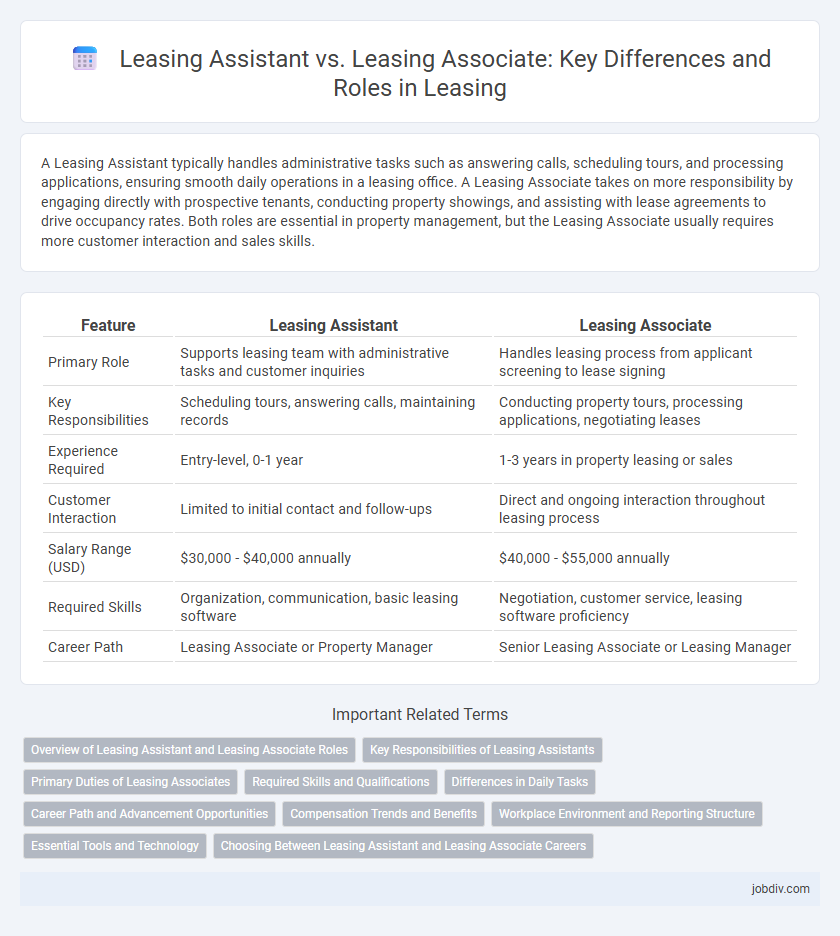A Leasing Assistant typically handles administrative tasks such as answering calls, scheduling tours, and processing applications, ensuring smooth daily operations in a leasing office. A Leasing Associate takes on more responsibility by engaging directly with prospective tenants, conducting property showings, and assisting with lease agreements to drive occupancy rates. Both roles are essential in property management, but the Leasing Associate usually requires more customer interaction and sales skills.
Table of Comparison
| Feature | Leasing Assistant | Leasing Associate |
|---|---|---|
| Primary Role | Supports leasing team with administrative tasks and customer inquiries | Handles leasing process from applicant screening to lease signing |
| Key Responsibilities | Scheduling tours, answering calls, maintaining records | Conducting property tours, processing applications, negotiating leases |
| Experience Required | Entry-level, 0-1 year | 1-3 years in property leasing or sales |
| Customer Interaction | Limited to initial contact and follow-ups | Direct and ongoing interaction throughout leasing process |
| Salary Range (USD) | $30,000 - $40,000 annually | $40,000 - $55,000 annually |
| Required Skills | Organization, communication, basic leasing software | Negotiation, customer service, leasing software proficiency |
| Career Path | Leasing Associate or Property Manager | Senior Leasing Associate or Leasing Manager |
Overview of Leasing Assistant and Leasing Associate Roles
Leasing Assistants primarily handle administrative tasks such as processing rental applications, scheduling property showings, and maintaining leasing documents, ensuring smooth day-to-day operations. Leasing Associates engage more directly with potential tenants, conducting property tours, explaining lease terms, and closing rental agreements to drive occupancy rates. Both roles require strong customer service skills and knowledge of leasing regulations, but Leasing Associates typically hold more responsibility in sales and tenant interaction.
Key Responsibilities of Leasing Assistants
Leasing Assistants primarily handle administrative tasks such as managing tenant inquiries, preparing lease documents, and coordinating property tours to support leasing agents. They ensure accurate data entry in property management software and maintain organized leasing files, contributing to efficient lease processing. This role emphasizes customer service and communication skills to assist prospective tenants effectively throughout the leasing process.
Primary Duties of Leasing Associates
Leasing Associates primarily manage tenant relations by processing applications, conducting property tours, and preparing lease agreements. They ensure compliance with leasing policies, coordinate move-in and move-out inspections, and address tenant concerns efficiently. Leasing Associates also support administrative tasks, maintain accurate leasing records, and facilitate communication between property management and prospective renters.
Required Skills and Qualifications
Leasing Assistants require strong organizational skills, basic knowledge of property management software, and excellent customer service abilities to support leasing agents and handle administrative tasks. Leasing Associates need more advanced skills, including proficiency in lease agreements, marketing strategies, tenant screening processes, and negotiation techniques. Both roles demand effective communication skills and familiarity with local leasing laws to ensure compliance and customer satisfaction.
Differences in Daily Tasks
Leasing Assistants primarily handle administrative duties such as processing applications, scheduling tours, and managing paperwork to support the leasing team. Leasing Associates engage more directly with prospective tenants by showing properties, discussing lease terms, and addressing tenant inquiries to facilitate leasing agreements. The key difference lies in Leasing Associates having a more client-facing role, while Leasing Assistants focus on back-office operations.
Career Path and Advancement Opportunities
Leasing Assistants typically handle administrative duties and customer inquiries, serving as entry-level positions that provide foundational industry knowledge and customer service experience. Leasing Associates often take on more responsibility, including showing properties, lease negotiations, and tenant relations, positioning them for supervisory roles or specialized real estate careers. Progression from Leasing Assistant to Leasing Associate can lead to advanced opportunities such as Leasing Manager or Property Manager, reflecting a clear career path within the leasing industry.
Compensation Trends and Benefits
Leasing Assistants typically receive entry-level compensation averaging $35,000 to $45,000 annually, while Leasing Associates earn between $40,000 and $55,000, reflecting their greater responsibilities and experience. Benefits for both roles often include health insurance, paid time off, and employee discounts, with Leasing Associates more likely to access performance bonuses and commission structures. Market trends indicate rising compensation aligned with multifamily housing demand, emphasizing skill development and customer service proficiency.
Workplace Environment and Reporting Structure
A Leasing Assistant often operates in a fast-paced office environment, supporting daily leasing operations with direct reporting to the Leasing Manager or Leasing Associate. Leasing Associates typically have a more client-facing role, working both in the leasing office and on the property, reporting to the Leasing Manager or Property Manager. The workplace environment for Leasing Associates involves more interaction with tenants and prospects, while Leasing Assistants focus on administrative and clerical support within the leasing team.
Essential Tools and Technology
Leasing Assistants primarily rely on property management software such as Yardi and AppFolio to handle administrative tasks and maintain tenant records efficiently. Leasing Associates utilize advanced customer relationship management (CRM) systems and digital leasing platforms to engage prospects and streamline the leasing process. Both roles depend on communication tools like email, phone systems, and virtual tour technology to enhance tenant interaction and improve lease conversion rates.
Choosing Between Leasing Assistant and Leasing Associate Careers
Choosing between Leasing Assistant and Leasing Associate careers depends on the level of responsibility and experience desired. Leasing Assistants typically handle administrative tasks, customer inquiries, and scheduling, making it ideal for entry-level candidates. Leasing Associates have more direct interaction with clients, lease negotiations, and property tours, requiring stronger communication skills and industry knowledge.
Leasing Assistant vs Leasing Associate Infographic

 jobdiv.com
jobdiv.com